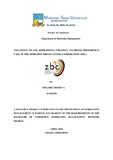Please use this identifier to cite or link to this item:
https://cris.library.msu.ac.zw//handle/11408/3189| Title: | Influence of the rebranding strategy on brand preference: case of the Zimbabwe Broadcasting Corporation (ZBC). | Authors: | Chodeva, Tinashe | Keywords: | Rebranding strategy Digitalisation Zimbabwe Broadcasting Corporation |
Issue Date: | 2018 | Publisher: | Midlands State University | Abstract: | This research study sought to investigate the influence of the rebranding strategy on brand preference: The case of Zimbabwe Broadcasting Corporation. The research sought to fulfil objectives such as the influence of digitalisation on perceived quality, influence of change in television content on brand likeability and the influence of change in programming on repeat business. Internal rebranding definition was drawn from Juntunen et al (2009) and the elements of brand preference were taken from different authors who include (Davies et al 2009, McMillan and Josh 2013, Richard and Zhang 2012). Interest in the researcher to carry out this research was triggered after noticing that the brand preference of ZBCTV was continuously decreasing as the general public now prefer most other channels such as DSTV, Kwese TV to mention but a few. Literature review was carried out on the above mentioned objectives as discussed by different authors to find the similarities and different authors who studied on rebranding and brand preference variables. A theoretical view discussed by authors’ shows that in the internal rebranding of a broadcasting corporation, changing television content was the most favorable strategy. Other factors of broadcast internal rebranding that is digitalisation and change in programming were also regarded as influential to customers but to a lesser extent as compared to change in television content. In carrying out the research, the researcher used descriptive and exploratory research design, both primary and secondary sources of data were used. A target population of 151 was used and a sample size of 114 was employed. Simple random sampling and convenience sampling were used to select the respondents as well as allowing flexibility on the part of the researcher to use readily available participants. STATA was used to analyze data and presentations were done in the form of tables and bar-graphs. From the findings it was noted that digitalisation has a positive influence on perceived quality as indicated by the R-squared of 0.6877 thus 69% of perceived quality is explained by digitalisation. A positive correlation exists between the two variables. From the run tests it was also noted that change in television content had a strong influence on brand likeability as it explained 73% of brand likeability. Moreso change in television programming has a positive relationship with repeat business and a strong positive correlation existed between the two variables. From the research findings, the researcher recommends the organization to direct marketing efforts on things that are strongly valued by the viewer and customers, to invest in modern equipment such as drone cameras and lastly to keep on creating brand awareness through live broadcasts and getting feedback from viewers and customers. | URI: | http://hdl.handle.net/11408/3189 |
| Appears in Collections: | Bachelor Of Commerce Marketing Management Honours Degree |
Files in This Item:
| File | Description | Size | Format | |
|---|---|---|---|---|
| First draft.pdf | Full Text | 1.53 MB | Adobe PDF |  View/Open |
Page view(s)
120
checked on Feb 26, 2025
Download(s)
120
checked on Feb 26, 2025
Google ScholarTM
Check
Items in MSUIR are protected by copyright, with all rights reserved, unless otherwise indicated.


